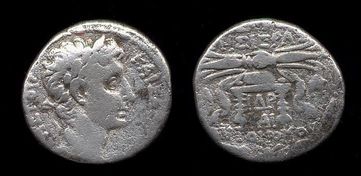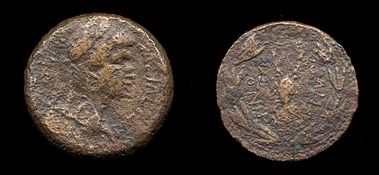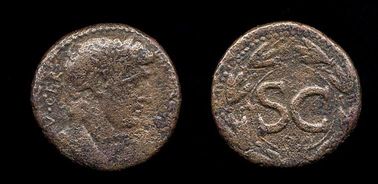Coin of Augustus. Syria: Seleucia Pieria, silver tetradrachm 25 mm. This is another splendid, large silver coin, similar to the one minted at Antioch (q.v.). It is also dated to 6 A.D. It is another example of the silver coins used throughout the Eastern empire, and not just in the mint city. It would make perfect sense to acquire an adequate number of these coins before one departed for other lands by sea, because, upon arrival in foreign lands, these coins would be quickly recognized, trusted and negotiable.
46 A.D. CYPRUS
Cyprus was most likely chosen as their first destination in part because Barnabas was a native of that island. There were also sizable Jewish synagogues there as well. More importantly, Cyprus, like Antioch, was one of the eventual safe havens for some of the “followers of Jesus” who fled from Judaea after Stephen’s martyrdom. It is assumed that there was some interaction between the believers in Antioch and those in Cyprus, they being so close to each other geographically.
Barnabas and Saul (for so he was still called) took their time moving through the island, from Salamis in the east to Paphos in the west. At Paphos, Barnabas and Saul were invited by the Roman proconsul Sergius Paulus to come see him and share with him their religious teaching. At this point Saul became Paul in order ‘to be all things to all men’. The Jewish Saul introduces himself to the proconsul as a Roman citizen, Paul. We will see repeatedly this ability of Paul to function well in either culture, Greek-Roman or Jewish.
And it was at the consul’s place where a supernatural event took place. When Barnabas and Saul arrived they were confronted by a crony of the consul, a magus by the name of Elymas (a.k.a. Bar-Jesus). This pagan magician opposed them, and incurred the anger of Paul who made Elymas blind “for a while”. This had great effect upon Sergius Paulus who began to believe in the teachings!
It is unfortunate that I have not been able to find a coin of Cyprus to represent this part of the voyage. The Pocket Guide to St. Paul says that there are coins of Tiberius and Claudius, and one by Tiberius honoring his son Drusus, but I have never seen them offered for sale or in any collections. Likewise I have not found any coins from the next cities visited, although issues do exist.
“Then Paul and his companions set sail from Paphos and came to Perga in Pamphylia”. Acts 13:13
Perga was several miles inland and was reached via the navigable river Kestros. Pamphylia is the Roman province situated on the south coast of Asia Minor, northwest from Cyprus. No evangelizing was done in Perga, but it was the south terminus of the Via Sebaste - a Roman road built by Augustus in 6 B.C. to link the cities and towns of southern Galatia. Apparently Barnabas and Paul decided to go to Pisidian Antioch upon the recommendation of Sergius Paulus, who was from there. But in addition, this Antioch in Pisidia was a major Roman colony and was situated on the main east-west highway from Ephesus to Syria. (Nota Bene: At this point in Acts the author switches from Saul to Paul permanently.)
46 A.D. PISIDIAN ANTIOCH
As for coins representative of Pisidian Antioch, there was a series minted in the 10s B.C. to celebrate the founding of the colony (by Augustus and originally called Colonia Caesareia Antiocheia). I would like to see some of these, but so far… One noteworthy event concerning Pisidian Antioch was that it was the place where Paul first preached to Gentiles (Acts 13: 46-48). Apparently in Cyprus he confined himself to the synagogues. Since he was the self-proclaimed ‘apostle to the Gentiles’ this in itself suggests that one of the aims of this journey was to find truly Roman cities, and Antioch in Pisidia was certainly one of those.
Apparently at P. Antioch these Gentiles were favorably impressed with the evangelists’ message, but the resident Jews were not and after one Sabbath meeting, they ran Paul and Barnabas out of town. So the two missionaries went on to Iconium. Iconium was a somewhat smaller town but better situated, standing at the intersection of six major roads. However, the same thing happened there as in Antioch. In the event, the two brothers in Christ heard beforehand of this plot to harm them and they moved on to the next nearest settlement, much smaller, basically a small town called Lystra. This was in a region known as Lycaonia.
48 A.D? LYCAONIAN GALATIA: Lystra, Laranda, Derbe
Lycaonia belonged to a different provincial region from that of Iconium and Pisidian Antioch; but there were still Jews there along with Gentiles. Paul’s message of there being neither Greek nor Jew in Christ was seen as blasphemy by them, and he met his most severe chastisement in Lystra and was almost killed by stoning. His enemies left him for dead!
And yet his message had fallen upon some appreciative ears. Sympathizers circled around him (Acts 14:20) and ministered to his wounds. They then brought him to Derbe, east of Lystra where he revived. Whilst he stayed there recuperating he seemed to find his voice. The people of Derbe were a mixed group of peasants who responded to his message of God’s own son. As Bruce Chilton (2004) puts it, “He had mastered a dynamic, persuasive technique of propagating Spirit, discovering a theme and an approach that would resonate with disaffected denizens of the Roman Empire everywhere-- and he knew it”.
I have to wonder about Barnabas? We are told nothing about him whilst Paul was getting beaten. After recuperating in Derbe, we are told in Acts (14:21) that he and Barnabas retraced their route and visited the same places again. But this was going back to places that had previously been hostile to them. Even if it had been several months or a year since some of the places had seen Paul and Barnabas, that is not too long to forget. This is puzzling in its account. Ramsay states that “new magistrates had now come into office in all the cities whence they had been driven; and it was therefore possible to go back”. But he does not give any reference to support this.
Throughout my description of this first foray by the brothers in Christ I have gone into some detail despite not having any coins to use as illustrations. I do this because such coins may be available in future and can be inserted. Fortunately, with the region that included Derbe (i.e. southern Lycaonia), we finally arrive at a coin that I did succeed in acquiring.
Coin of Antiochus IV. Galatia: Lycaonia, Laranda-Derbe, bronze 27 mm. Antiochus was a client king of Rome who ruled a region called Commagene, the most northerly district in Syria. Through a series of political machinations, Antiochus received control over Lycaonia (and other regions). Being in Derbe and passing through Laranda, Paul would have seen this large, bronze coin. It is dated broadly from 38 to 72 A.D. It features an interesting reverse, a scorpion, the symbol of Antiochus and his native Commagene. Laranda is mentioned because it was actually the main city of Lycaonia, not Derbe. However the two towns are very proximate to each other.
49 A.D. ANTIOCH
Acts (14:25) tells us that Paul and Barnabas sailed back to Syrian Antioch from the port of Attalia (near Perga). The date now is about 49 A.D. The Pocket Guide lists four bronze coins minted in Attalia from the time of Augustus to the time of Paul’s arrival. Paul would have seen some of them but hardly anyone today has. Now, this brings us back to where Barnabas and Paul began, the great eastern city of Antioch on the Orontes in Syria, and officially ends the First Missionary Journey.
Upon Paul and Barnabas’ return to Antioch they would have seen a quite new coin very recently minted under the authority of a Roman official named Cassius (C. Cassius Longinus) for the emperor Claudius. [N.B.: We know from research that this official was governor of Syria from A.D. 44 or 45 until 50].
Coin of Claudius. Syria: Antioch, bronze 26 mm. This group is called the SC series for the use of the large letters S & C on the reverse. They were minted in 47-48 A.D. There is some doubt as to what “SC” means. Some scholars believe it refers to the motto Senatus Consultus, i.e. by the consultation and approval of the Senate of Rome (cf. the equally famous acronym S.P.Q.R.) This is a very large, heavy and quite handsome coin of the emperor Claudius.
49 A.D. APOSTOLIC COUNCIL at JERUSALEM
We are not given any specifics on how long the two evangelists stayed in Antioch, with Acts merely stating “for some time”. However at some point a considerable dissension began within the Antiochan community on account of “certain individuals [who] came down from Judaea and were teaching… ‘Unless you are circumcised according to the custom of Moses you cannot be saved’”. As a result Paul, Barnabas and others were appointed by the congregation to go to Jerusalem to discuss this question. This was the noteworthy Apostolic Council.
(Page 3)



